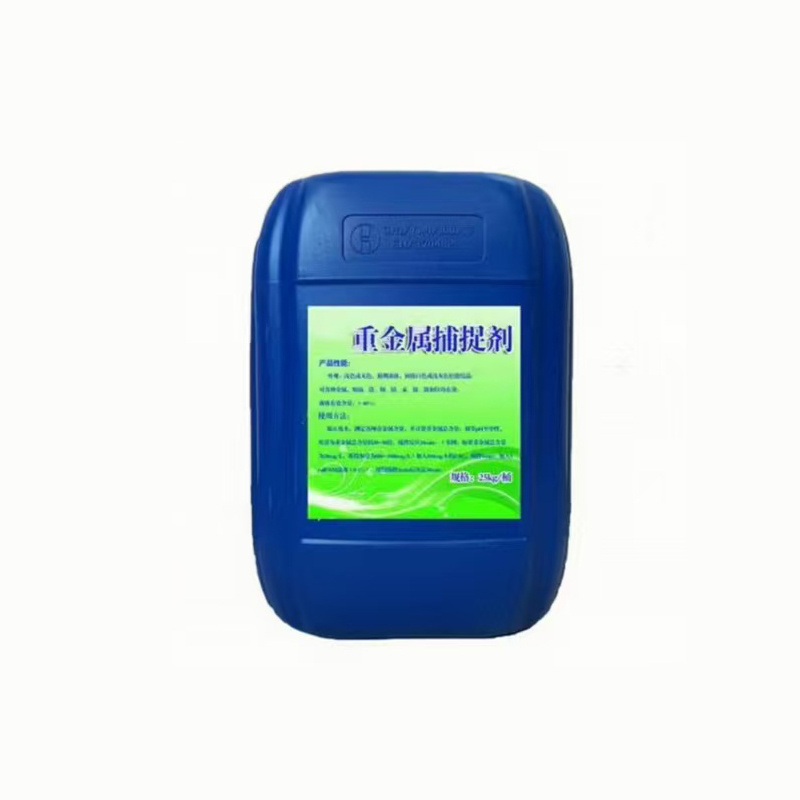

Heavy metal capture agent
Heavy metal scavenger is a chemical agent that strongly chelates with heavy metal ions,Due to its ability to interact with wastewater at room temperature and a wide range of pH conditions Various substances such as Cu2+, Cd2+, Hg2+, Pb2+, Mn2+, Ni2+, Zn2+, Cr3+, etc
Heavy metal ions undergo chemical reactions and rapidly generate in a short period of time Insoluble, low moisture content, and easily filtered flocculent precipitate, thus achieving the goal of removing from The chemicals used to remove heavy metal ions from wastewater are called heavy metal scavengers.
- Product Description
Product Description
Heavy metal scavenger is a chemical agent that strongly chelates with heavy metal ions,Due to its ability to interact with wastewater at room temperature and a wide range of pH conditionsVarious substances such as Cu2+, Cd2+, Hg2+, Pb2+, Mn2+, Ni2+, Zn2+, Cr3+, etc
Heavy metal ions undergo chemical reactions and rapidly generate in a short period of time Insoluble, low moisture content, and easily filtered flocculent precipitate, thus achieving the goal of removing from The chemicals used to remove heavy metal ions from wastewater are called heavy metal scavengers.
physical property:
● Deposition of metal in the broad pH range;
● Realize the circulation of factory production wastewater;
● Can be used for conventional treatment processes or as a polishing agent for wastewater treatment;
● It is effective against various metals such as cadmium, chromium, copper, lead, mercury, nickel, silver and zinc.
Product Description:
Heavy metal scavengers are liquid metal precipitation agents that effectively remove metal ions, reducing their concentration in wastewater. These agents are commonly used as a polishing step following conventional metal precipitation ocesses like hydroxide precipitation. Compared to traditional methods for handling high-concentration metal ions, this approach is considered a viable alternative.
Due to its strong chelating properties, the reaction can not only be carried out at room temperature and a wide range of pH values, but also is not affected by the concentration of heavy metal ions. Even if the wastewater contains complex components, it can precipitate all kinds of heavy metal ions in one time, so that the wastewater can meet the discharge standards.
There are two main synthesis routes for heavy metal scavengers:
One is that the monomer containing chelating group is prepared by addition polymerization, polycondensation, stepwise polymerization or ring-opening polymerization;
Another approach involves synthesizing chelating functional chain groups through polymer chemical reactions using synthetic or natural high molecular fractions. In practical research applications, two main types of heavy metal chelators are widely used:xanthanate esters and disulfide amine carboxylates (DTC derivatives), with DTC derivatives being the most extensively applied.
Industry of use:
1. Removal of heavy metals in wastewater treatment of electroplating plant;
2. Heavy metal removal in wastewater treatment of electronic circuit board factory;
3. Removal of heavy metals in tailings wastewater treatment;
4. Removal of heavy metals in metallurgical wastewater treatment;
5. Removal of heavy metals in wastewater treatment of chemical and leather industries.
Product Features:
1. It has strong chelating ability and can effectively react with heavy metals to generate insoluble substances, especially mercury and cadmium, mainly used in wet sulfur processes
During the process;
2. It can adsorb almost all heavy metals, especially in wastewater treatment, and can remove all dissolved residual heavy metals through simple treatment;
3. Metal precipitates have good temperature stability and are difficult to release heavy metals back into the environment, making them environmentally friendly heavy metal capture agents;
4. Has good toxicological and biological properties, with low toxicity;
5. It has good storage stability and operational safety, does not belong to dangerous goods, mostly has no adverse odor, and does not decompose into toxic substances.
Product Usage
This product is used for heavy metal removal in wastewater treatment across multiple industries: electroplating plants, printed circuit board factories, mining tailings facilities, metallurgical processes, and chemical/leather industry wastewater. The solution employs a simple method requiring no new equipment—just adding a chelating agent to remove heavy metals. The agent strongly complexes with metal ions to form effective flocs, delivering excellent flocculation results with minimal sludge production and easy dewatering.
Usage method :
① The content of heavy metal ions in wastewater was tested first, and the optimal dosage of chemical was determined by simulated dosing test.
② The pH value of the wastewater should be adjusted to 7-9 before adding the medicine for best effect.
③ Determine the total daily dosage based on the wastewater volume to be processed. Before dosing, dilute the measured chemical solution to a 1-2% concentration using a dedicated dosing system. Add the diluted solution continuously or in batches into the wastewater. During treatment, ensure thorough mixing of the wastewater and chemical for approximately 5-10 minutes, then incorporate appropriate amounts of flocculant and coagulant aid while maintaining continuous stirring.
④ After mixing, the heavy metal precipitates are generally left for 10 minutes before being separated from water, and then the heavy metal precipitates are filtered and pressed by a filter press. The filter cake containing heavy metal is treated as non-leachable toxic waste and buried deep, and the filtered water can be discharged according to the standard.
Packaging:
Heavy metal scavenger is a liquid mixture, weighing 25Kg or 200Kg per barrel. It should be stored in a cool and dry environment. When not in use, keep the container tightly sealed.
Avoid freezing. If frozen, thoroughly thaw and mix before use.

We'd love to hear from you.
Please leave a message, we will get in touch with you as soon as possible!











 Home
Home






